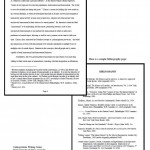
Chicago Style Research Paper
What Chicago Style Means and How to apply it to your Research Paper
Chicago Style is simply another format to writing a research paper – like Harvard, MLA or APA. It is also referred to as Turabian style, after the manual written by Kate Turabian who championed this style of formatting. Chicago style is most usually used when writing historical papers or other humanity subjects such as arts or literature.
The main thing you need to understand about producing a Chicago style paper is to do with citations. All your references are denoted in text by a superscript number, 1,2,3 etc. Then the bibliographic information is placed at the bottom of the page as a footnote with the corresponding number. These footnotes also allow you to place short comments, meaning there is no need to break your line of text in the paper itself. At the end of the paper the list of these sources – the bibliography – is listed alphabetically according to author (or book title if there is no known author). Because of this the Chicago format is very user-friendly. It is easy for the reader to immediately glance at the bottom of the page to follow up on the reference without having to break concentration by turning to the end of the paper.
Chicago style has strict guidelines on the formatting, with specific requirements for the first footnote and following footnotes and the bibliography. Depending on the source of your research there are specific ways how to set this information out. It also gives advice on how to undertake research and formulate your hypothesis.
 Quick Navigation through the Chicago Style Research Paper Page
Quick Navigation through the Chicago Style Research Paper Page
- What Chicago Style Means and How to apply it to your Research Paper
- Download Free Chicago Style Research Paper Sample
- Chicago Style Research Paper: from a Topic to a Research Argument
- How to Insert Footnotes and Endnotes?
- How Can We Help
- How to use Paraphrases and Quotations Effectively
- Rules for Formatting Chicago Style Footnotes
- Rules for Formating Chicago Style Bibliography
Download Free Sample of Chicago Style Research Paper
Chicago Style Research Paper: from a Topic to a Research Argument
The manual written by Kate Turabian contains useful tips not only on how to cite properly, but also on how to do the research and write a research paper. This advice will help to make your Chicago style research paper more coherent and logically connected.
Chicago Style Research Paper Sample
(Click the image to enlarge)
- The first thing you need to do before you write a Chicago style research paper is to take your given subject, for example ‘The Massacre at Fort Pillow,’ and find a question in it. In this example perhaps it could be ‘who should be held responsible for the fact that the Union soldiers, and the black soldiers in particular, were killed after surrendering?’
- Once you have your question you need to propose some working answers. This is done by researching your subject from a variety of sources. In the case of our example it could be that Major General Nathan Bedford Forrest should be held accountable for the massacre.
- By using the information gained you can then formulate your research hypothesis. For instance, for our research paper on the Massacre at Fort Pillow, the research hypothesis may be the following: “Major General Nathan Bedford Forrest should be held responsible for the Massacre at Fort Pillow because the massacre of surrendered soldiers was premeditated”.
- Once this is done you can build your research paper around your argument and reasons that will support your claim.
Try to imagine what your reader will be asking when reading your paper. Indeed, their questions are highly likely to be similar to the ones you are asking. Build your argument around these questions.
How to Insert Footnotes and Endnotes?
The most remarkable feature of a Chicago style research paper are the footnotes and endnotes.
Thus the references are marked in your text by using superscript Arabic numbers, which then correspond to the reference information presented either in footnotes or endnotes. But when doing a Chicago style research paper for the first time you may need an explanation on how to insert a footnote or endnote in your text.
To make a footnote insert your cursor where you wish the footnote or endnote to appear. Click the ‘references’ ribbon and then click ‘Insert Footnote.’ The relevant superscript number will appear and you will be either taken to the bottom of the current page for a footnote, or to the end of the document for an endnote, and you can then type your citation information.
If the numbering format is not correct, or you wish to change it, click the expand arrow in the footnotes section of the references ribbon and you can then change the numbering as you wish.
How We Can Help
One simple and hassle free way of producing a Chicago style research paper is by ordering a custom written paper from ProfEssays.com. We specialize in providing quality custom research papers in all subjects. Your paper is guaranteed to be free from any form of plagiarism as all papers written by our writers are submitted to meticulous and rigorous anti- plagiarism software before being sent over to the customer. Having your paper produced by our team of professional and certified academic writers ensures you of unique content as it will be customized to your exact requirements.
Prompt delivery of your order is guaranteed. In fact, if you need a paper delivered urgently we can have it completed and returned to you within eight hours. In addition to this, we guarantee complete customer satisfaction. We are so confident of our claim that we offer an unlimited number of revisions – free of charge – until you are completely satisfied.
As well as guaranteeing the quality of your Chicago style research paper, we also guarantee your privacy and security and ensure 100% confidentiality at all times. Payment methods are also undertaken with your safety and security as top priority. To the end we only use one of the leading payment transaction methods. This is undertaken by a company who has a superb reputation in the world of technology, and consistently provides secure internet transactions.
ProfEssays.com also has a dedicated customer support team who are on hand 24/7. Please feel free to contact them at any point with queries about our services or your order. We are proud to offer this premium service at rates which constantly remain reasonable and affordable.
How to Use Paraphrases and Quotations Effectively
A quotation is a direct quote from a research source – so you write down the quote exactly as the original. A paraphrase is when you copy an idea or quote but re-write it in your own words. It is very important to understand the difference between the two.
There are different ways to insert this information into your paper, and you should attempt to use a variety of the following rather than just sticking to a single method.
You can incorporate quotations directly into a sentence of your own. This should be done in the following manner:
At 3:30 p.m., Forrest demanded the surrender of the Union forces, sending in a message of the sort he had used before: “The conduct of the officers and men garrisoning Fort Pillow has been such as to entitle them to being treated as prisoners of war. . . . Should my demand be refused, I cannot be responsible for the fate of your command.2”
As you can see the quote is surrounded by quotation marks. Ellipses denote missing words of text which you consider not necessary to quote.
Another example is to quote a complete block of text, as per the following example taken from Shelby Foote’s book.
Shelby Foote describes the scene like this:
- Some kept going, right on into the river, where a number drowned and the swimmers became targets for marksmen on the bluff. Others, dropping their guns in terror, ran back toward the Confederates with their hands up, and of these some were spared as prisoners, while others were shot down in the act of surrender.4
As you can see this is indented and there are no quotation marks surrounding the text.
However, to antagonize and support your research paper argument, paraphrasing is a very powerful means. Remember that paraphrasing also requires page numbers in your footnotes when using the Chicago style.
Rules for Formating Chicago Style Footnotes
Certain rules apply as to how your footnotes should be formatted. These should be strictly adhered to – with no exceptions. Footnotes should begin with an Arabic numeral, be indented on the first line by five spaces, be single spaced and have no periods.
The first footnote should be a full bibliographic entry:
- It should provide the author’s full name starting with the first name. If there are two or three authors they should be listed in the same way. For more than four authors, only the first should be quoted here, followed by the words et al. The remaining authors should be specified in the bibliography.
Example: John Cimprich and Robert C. Mainfort Jr,
Example: Dana Barnes et al.
- You then state the title of the work, book, journal or source. If quoting a whole work, then title is given in italics. However, if the piece quoted is from a smaller section inside the works, then the title of this section (a chapter or an article) should be enclosed in quotation marks.
Example of referencing a book: Gabriel García Márquez, Love in the Time of Cholera
Example of referencing an article: John Cimprich and Robert C. Mainfort Jr., eds., “Fort
Pillow Revisited: New Evidence about an Old Controversy,” Civil
War History 28, no. 4
- Information about the publisher is (usually) enclosed in parenthesis.
Example of referencing a book: (Chicago: University of Chicago Press, 2010),
Example of referencing a journal article: Classical Philology 104 (2009)
Example of referencing a newspaper: February 27, 2010, accessed February 28, 2010
Note that a newspaper (or magazine) reference has no parenthesis.
First footnote for on-line sources should be written in the following format:
Philip B. Kurland and Ralph Lerner, eds., The Founders’ Constitution (Chicago: University of Chicago Press, 1987), accessed February 28, 2010, http://press-pubs.uchicago.edu/founders/
- The page number or numbers go the last.
Therefore, the first footnote for a journal article should look like this:
1. John Cimprich and Robert C. Mainfort Jr., eds., “Fort Pillow Revisited: New Evidence about an Old Controversy,” Civil War History 28, no. 4 (1982): 293-94.
The subsequent footnotes contain way less information. They don’t include the author’s first name (only the last name) or publisher information, and the title is shortened to one or two words (most usually the first word). For on-line sources there is no link or access date.
The following are examples of subsequent footnotes:
Cimprich and Mainfort, “Fort Pillow,” 295
Foote, Civil War, 111
García Márquez, Cholera, 33
Rules for Formating Chicago Style Bibliography
The bibliography goes at the very end of your research paper and gives you full information on all the references used.
- Bibliography should start with a new page. It is written in alphabetical order according to the author’s last names. If there is no author then the publication title is used instead.
-
Each part of the bibliographic entry is divided by periods, unlike the footnotes.
-
The first line of the entry should be at the margin, the rest are indented by five spaces (1/2”).
-
Generally the entries should be single spaces for each one, with double spaces between entries.
Examples of different sources are as follows:
Castel, Albert. “The Fort Pillow Massacre: A Fresh Examination of the Evidence.” Civil War History 4, no. 1 (1958): 37-50.
Cimprich, John, and Robert C. Mainfort Jr., eds. “Fort Pillow Revisited: New Evidence about an Old Controversy.” Civil War History 28, no. 4 (1982): 293-306.
Forrest, Nathan Bedford. “Report of Maj. Gen. Nathan B. Forrest, C. S. Army, Commanding Cavalry, of the Capture of Fort Pillow.” Shotgun’s Home of the American Civil War. http://www.civilwarhome.com/forrest.htm.
 + 1-888-827-0150
+ 1-888-827-0150 + 44-20-3006-2750
+ 44-20-3006-2750













